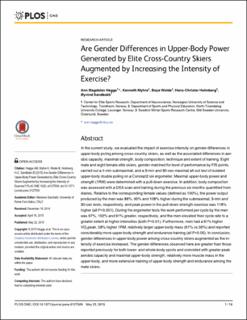| dc.contributor.author | Hegge, Ann Magdalen | |
| dc.contributor.author | Myhre, Kenneth | |
| dc.contributor.author | Welde, Boye | |
| dc.contributor.author | Holmberg, Hans-Christer | |
| dc.contributor.author | Sandbakk, Øyvind | |
| dc.date.accessioned | 2020-03-20T10:12:03Z | |
| dc.date.available | 2020-03-20T10:12:03Z | |
| dc.date.created | 2016-01-21T20:23:55Z | |
| dc.date.issued | 2015 | |
| dc.identifier.citation | PLOS ONE. 2015, 10(5): e0127509 | en_US |
| dc.identifier.issn | 1932-6203 | |
| dc.identifier.uri | https://hdl.handle.net/11250/2647759 | |
| dc.description.abstract | In the current study, we evaluated the impact of exercise intensity on gender differences in upper-body poling among cross-country skiers, as well as the associated differences in aerobic capacity, maximal strength, body composition, technique and extent of training. Eight male and eight female elite skiers, gender-matched for level of performance by FIS points, carried out a 4-min submaximal, and a 3-min and 30-sec maximal all-out test of isolated upper-body double poling on a Concept2 ski ergometer. Maximal upper-body power and strength (1RM) were determined with a pull-down exercise. In addition, body composition was assessed with a DXA scan and training during the previous six months quantified from diaries. Relative to the corresponding female values (defined as 100%), the power output produced by the men was 88%, 95% and 108% higher during the submaximal, 3-min and 30-sec tests, respectively, and peak power in the pull-down strength exercise was 118% higher (all P<0.001). During the ergometer tests the work performed per cycle by the men was 97%, 102% and 91% greater, respectively, and the men elevated their cycle rate to a greater extent at higher intensities (both P<0.01). Furthermore, men had a 61% higher VO2peak, 58% higher 1RM, relatively larger upper-body mass (61% vs 56%) and reported considerably more upper-body strength and endurance training (all P<0.05). In conclusion, gender differences in upper-body power among cross-country skiers augmented as the intensity of exercise increased. The gender differences observed here are greater than those reported previously for both lower- and whole-body sports and coincided with greater peak aerobic capacity and maximal upper-body strength, relatively more muscle mass in the upper-body, and more extensive training of upper-body strength and endurance among the male skiers. | en_US |
| dc.language.iso | eng | en_US |
| dc.publisher | PLOS, Public Library of Science | en_US |
| dc.relation.uri | http://journals.plos.org/plosone/article?id=10.1371/journal.pone.0127509 | |
| dc.rights | Navngivelse 4.0 Internasjonal | * |
| dc.rights.uri | http://creativecommons.org/licenses/by/4.0/deed.no | * |
| dc.title | Are gender differences in upper-body power generated by elite cross-country skiers augmented by increasing the intensity of exercise? | en_US |
| dc.type | Peer reviewed | en_US |
| dc.type | Journal article | en_US |
| dc.description.version | publishedVersion | en_US |
| dc.source.pagenumber | 16 | en_US |
| dc.source.volume | 10 | en_US |
| dc.source.journal | PLOS ONE | en_US |
| dc.source.issue | 5 | en_US |
| dc.identifier.doi | 10.1371/journal.pone.0127509 | |
| dc.identifier.cristin | 1319892 | |
| dc.description.localcode | Copyright: © 2015 Hegge et al. This is an open access article distributed under the terms of the Creative Commons Attribution License, which permits unrestricted use, distribution, and reproduction in any medium, provided the original author and source are credited. | en_US |
| cristin.ispublished | true | |
| cristin.fulltext | original | |
| cristin.qualitycode | 1 | |

